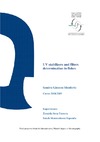Please use this identifier to cite or link to this item:
https://accedacris.ulpgc.es/jspui/handle/10553/74462
| Title: | UV stabilizers and filters determination in fishes | Authors: | Gimeno Monforte, Sandra | Director: | Sosa Ferrera, María Zoraida Montesdeoca Esponda, Sarah |
UNESCO Clasification: | 2301 química analítica | Keywords: | UV stabilizers UV filter Fish MAE UHPLC-MS/MS |
Issue Date: | 2020 | Abstract: | The use of ultraviolet (UV) filters and stabilizers in personal care products (PCPs), plastics and textiles, is rising due to the necessity of protection that our skin and the different objects exposed to sun light required against the UV radiation. This increase of their use and the poor elimination at the wastewater treatment plants (WWTPs) generate a continuous discharge of these compounds to rivers, lakes and seas that could pollute the environment and result in health problems in organisms. The negative effect in fishes has been demonstrated, they exhibit endocrine disrupting properties, induced morphological abnormalities during embryonic development and have inflammatory and immunotoxic properties. Because of the high persistence of these compounds in tissues, the effect of bioaccumulation and biomagnification in the trophic chain, and their presence in human samples, it is necessary to know their presence in fishes bought from local markets. In this study a method based in on Microwave-Assisted Extraction (MAE) and Ultra- High Performance Liquid Chromatography with tandem mass spectrometry detection (UHPLC-MS/MS) to determinate 6 UV stabilizers and 7 UV filters in fish was developed. The method was successfully applied to the determination of the target compounds in 9 different fish species. Among the studied compounds, Benzophenone-3 was the most detected (in 7 of the species) followed by UV-329. They presented the highest concentrations in fish tissues, .682.5 ng g-1 dry weight (dw) of BP-3 in Thunnus thynnus and 364 ng g-1 dry weight (dw) of UV-329 in Sarda sarda samples. The levels of these compounds could be related with the trophic level and the location of fish species. | Department: | Departamento de Química | Faculty: | Facultad de Ciencias del Mar | Degree: | Máster Universitario en Oceanografía por la Universidad de Cádiz, la Universidad de Las Palmas de Gran Canaria y la Universidad de Vigo | URI: | https://accedacris.ulpgc.es/handle/10553/74462 |
| Appears in Collections: | Trabajo final de máster Restringido ULPGC |
En el caso de que no encuentre el documento puede ser debido a que el centro o las/os autoras/es no autorizan su publicación. Si tiene verdadero interés en el contenido del mismo, puede dirigirse al director/a o directores/as del trabajo cuyos datos encontrará más arriba.
Show full item recordItems in accedaCRIS are protected by copyright, with all rights reserved, unless otherwise indicated.
